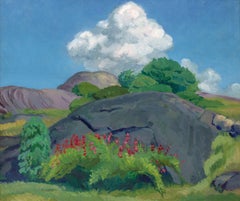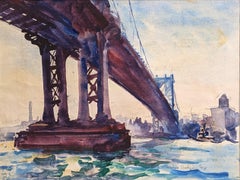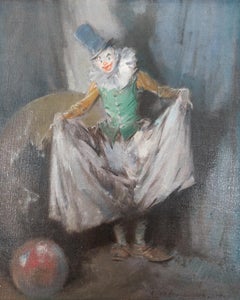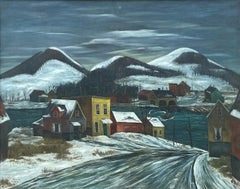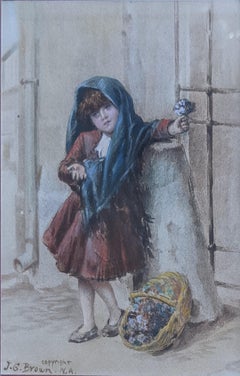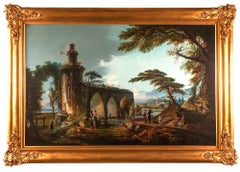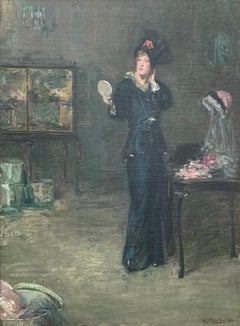Ashcan School Paintings
Style: Ashcan School
Color: Gray
White Cloud and Rock
By John Sloan
Located in New York, NY
Known as the “dean of American artists,” John Sloan was one of the most influential members of the Ashcan school.
Category
1910s Ashcan School Paintings
Materials
Oil
Bridge to Brooklyn #382
Located in Salt Lake City, UT
Bridge to Brooklyn #382, watercolor, 10.5 x 14 inches (Framed size: 18 x 21 inches), $1,750
Waldo Midgley (1888-1986) had a fruitful career spanning eig...
Category
1970s Ashcan School Paintings
Materials
Watercolor
Clown with Big Pants
Located in New York, NY
Clown With Big Pants, 1942, by Everett Shinn (1876-1953)
Oil on canvas
12 x 10 inches unframed (30.48 x 25.4 cm)
19 ½ x 17 ¼ inches framed (49.53 x 43.815 cm)
Signed and dated on bot...
Category
20th Century Ashcan School Paintings
Materials
Oil
"The Ferry No. 2, " Charles Harsanyi, Modern, Large WPA Ashcan Landscape Scene
By Charles E. Harsanyi
Located in New York, NY
Charles E. Harsanyi (1905 - 1973)
The Ferry No. 2, 1946
Oil on canvas
40 x 52 inches
Signed, titled and dated on the reverse
Provenance:
The artist
Grand Central Art Galleries, New York
Private Collection, New York
Kappell Gallery, Greenport, New York
Private Collection, Long Island, circa 2002
Exhibited:
New York, Grand Central Art Galleries, Critics' Show, December 10 - 21, 1946.
Charles E. Harsanyi was born in Tapolcza, Hungary in 1905. He studied at the Royal Academy in Budapest, Hungary with A. Bankhard from 1923 to 1928. Nineteen years later, in 1947, Harsanyi moved to the U. S., settling in Jackson Heights, New York.
The painter and drawing specialist became a member of numerous prestigious art clubs including the Salmagundi Club, The Society of Independent Artists and the Allied Artists of America. Harsanyi served as an awards director and chairman of admissions for the Audubon Artists Association during the 1950s. Later in life after living in Stephentown, New York and Cape Coral...
Category
1940s Ashcan School Paintings
Materials
Canvas, Oil
"Portland Harbor, Maine, " Alexander Bower, Snowy River Scene in Winter
Located in New York, NY
Alexander Bower (1875 - 1952)
Portland Harbor, Maine, 1910
Oil on canvas
27 x 33 inches
Signed and dated lower right
An American Impressionist, Alexande Bower was born in New York, studied at The Pennsylvania Academy of Fine Art, and was living with his wife in Cliff Island, Maine by 1914. Despite his urban upbringing, the coast and the sea fascinated Bower. A large portion of his paintings are seascapes, particularly scenes depicting the coast of Cape Elizabeth...
Category
1910s Ashcan School Paintings
Materials
Canvas, Oil
"Flower Girl, " John George Brown, Genre Painting, Street Figure
Located in New York, NY
John George Brown (1831 - 1913)
Flower Girl, circa 1900
Watercolor on paper
6 3/4 x 4 3/4 inches
Signed lower left
Period Hand Carved Foster Brothers Fram...
Category
Early 1900s Ashcan School Paintings
Materials
Paper, Watercolor
Standing Female Nude
Located in Fairlawn, OH
Standing Female Nude
Oil on canvas, c. 1910
Signed lower left corner (see photo)
Condition: Excellent
Housed in a 22K Gold Leaf ...
Category
1910s Ashcan School Paintings
Materials
Oil
In the Style of Ashcan School Painting
Located in San Francisco, CA
Neat little mystery oil on canvas. A moody street and cafe scene. It is in the style of the Ashcan School. It measures 1 inches wide by 8 high and is unframed. I t does not appear to...
Category
1970s Ashcan School Paintings
Materials
Oil
Carrot Top
Located in Lawrence, NY
Margery Ryerson was a pupil of Charles Hawthorne at the Cape School of Art in Provincetown, MA and with Robert Henri at the Art Students League in New York.
For a twenty-year perio...
Category
1920s Ashcan School Paintings
Materials
Oil
Woman in Red
Located in Buffalo, NY
Alexander O. Levy was a painter, illustrator,
printmaker and designer who was born in 1881 in Bonn, Germany. He
died in 1946 in Buffalo, New York. At age three, he was brought to
...
Category
1920s Ashcan School Paintings
Materials
Oil, Wood Panel
SISTERS AT THE WINDOW
By John Sloan
Located in Portland, ME
Sloan, John. SISTERS AT THE WINDOW. Etching, 1923 (M. 208). 5" x 4", signed and titled in pencil and inscribed "100 Proofs," of which only 76 were printed this being one of 25 early ...
Category
1920s Ashcan School Paintings
Materials
Etching
Related Items
'Agay, le château et le Sémaphore'. Oil on canvas. Signed.
Located in Paris, FR
'Agay, le château et le Sémaphore'.
Oil on canvas. +/- 1922
Signed lower right
Measurements : 60 x 73 cm.
This painting will be recorded in the second volume of the Catalogue Raisonn...
Category
1920s Ashcan School Paintings
Materials
Oil
H 23.63 in W 28.75 in
Oil painting; Italian Landscape in the style of Claude Lorraine (1600-1682).
By Claude Lorrain (circle of)
Located in Uppingham, GB
Large Italian Landscape circa 1890 painted by a heavily influenced follower of Claude Lorraine (1600-1682). Superb depth and detail. Indistinc...
Category
Late 19th Century Ashcan School Paintings
Materials
Oil
Landscape with Ciociaria Shepherd, the Bridge over the Tiber river and Ruins.
By Paul Pascal
Located in Firenze, IT
Landscape with Ciociaria shepherd, the bridge over the Tiber river and the ancient ruins by Paul Pascal (1839-1905).
Around 1880.
Gouache on paper.
Dimensions with frame: cm 69 x...
Category
1880s Ashcan School Paintings
Materials
Paper, Gouache
Free Shipping
H 20.08 in W 27.17 in D 0.79 in
A Canal in Venice, Hanging Out The Washing......
Located in Cotignac, FR
A watercolour on paper view of a canal in Venice by French artist Paule Soulé. The pain ting is signed bottom right and presented in a gilt and painted wood frame under glass.
A cha...
Category
Early 20th Century Ashcan School Paintings
Materials
Watercolor, Pencil, Paper
Freya (Seated Backwards), Mixed media on grey board
Located in London, GB
Howard Tangye (b.1948, Australia) has been an influential force in fashion for decades. Lecturing at London’s Central Saint Martins for 35 years, including 16 years as head of BA Wom...
Category
2010s Ashcan School Paintings
Materials
Other Medium, Archival Paper, Handmade Paper, Pen, Felt Pen, Permanent M...
Surrealist Gouache Watercolour on Paper.
Located in Cotignac, FR
Late 20th century gouache and watercolour on paper by British artist Derek Carruthers. The painting is signed to the bottom right and signed and dated 1985 to the reverse.
An impos...
Category
Late 20th Century Ashcan School Paintings
Materials
Paper, Watercolor, Gouache
"Jazz Club"
By Jane Gibbs
Located in Lambertville, NJ
Signed Lower Left
Category
20th Century Ashcan School Paintings
Materials
Canvas, Oil
Early oil depicting the Great Fire of London
Located in London, GB
The Great Fire of London in September 1666 was one of the greatest disasters in the city’s history. The City, with its wooden houses crowded together in narrow streets, was a natural fire risk, and predictions that London would burn down became a shocking reality. The fire began in a bakery in Pudding Lane, an area near the Thames teeming with warehouses and shops full of flammable materials, such as timber, oil, coal, pitch and turpentine. Inevitably the fire spread rapidly from this area into the City. Our painting depicts the impact of the fire on those who were caught in it and creates a very dramatic impression of what the fire was like. Closer inspection reveals a scene of chaos and panic with people running out of the gates. It shows Cripplegate in the north of the City, with St Giles without Cripplegate to its left, in flames (on the site of the present day Barbican). The painting probably represents the fire on the night of Tuesday 4 September, when four-fifths of the City was burning at once, including St Paul's Cathedral. Old St Paul’s can be seen to the right of the canvas, the medieval church with its thick stone walls, was considered a place of safety, but the building was covered in wooden scaffolding as it was in the midst of being restored by the then little known architect, Christopher Wren and caught fire. Our painting seems to depict a specific moment on the Tuesday night when the lead on St Paul’s caught fire and, as the diarist John Evelyn described: ‘the stones of Paul’s flew like grenades, the melting lead running down the streets in a stream and the very pavements glowing with the firey redness, so as no horse, nor man, was able to tread on them.’
Although the loss of life was minimal, some accounts record only sixteen perished, the magnitude of the property loss was shocking – some four hundred and thirty acres, about eighty per cent of the City proper was destroyed, including over thirteen thousand houses, eighty-nine churches, and fifty-two Guild Halls. Thousands were homeless and financially ruined. The Great Fire, and the subsequent fire of 1676, which destroyed over six hundred houses south of the Thames, changed the appearance of London forever. The one constructive outcome of the Great Fire was that the plague, which had devastated the population of London since 1665, diminished greatly, due to the mass death of the plague-carrying rats in the blaze.
The fire was widely reported in eyewitness accounts, newspapers, letters and diaries. Samuel Pepys recorded climbing the steeple of Barking Church from which he viewed the destroyed City: ‘the saddest sight of desolation that I ever saw.’ There was an official enquiry into the causes of the fire, petitions to the King and Lord Mayor to rebuild, new legislation and building Acts. Naturally, the fire became a dramatic and extremely popular subject for painters and engravers. A group of works relatively closely related to the present picture have been traditionally ascribed to Jan Griffier...
Category
17th Century Ashcan School Paintings
Materials
Oil, Canvas
Edward Lear, Extensive Greek Italian Landscape, Antique Ruins, Campagna di Roma
By Edward Lear
Located in Greven, DE
Most accounts of the artistic achievements of Edward Lear (1812–1888) take as their starting point the notion that he is better known as the writer of nonsense verse than as a topographical draughtsman and painter. His art is then considered largely in isolation, as the extraordinary creation of a fascinatingly eccentric Victorian. However, Lear's art is outstanding.
Although Lear suffered from epilepsy, asthma, poor eyesight, and chronic depression, he was an inveterate traveler and an indefatigable sketcher, documenting a lifetime of journeys throughout the Mediterranean and India.
During his two-month tour to Athens, mainland Greece and the island of Euboea, Edward Lear made almost 150 landscape drawings and kept a diary of his experiences and impressions. Many years later, Lear’s travelling companion, Charles Church...
Category
19th Century Ashcan School Paintings
Materials
Watercolor
1940s New York Interior -- An Evening Scene of Artist and His Wife
Located in Soquel, CA
1940s New York Interior -- An Evening Scene of Artist and His Wife
Wonderful moody 1940s New York interior and figurative oil painting in Ashcan Schoo...
Category
1940s Ashcan School Paintings
Materials
Oil, Canvas, Cardboard
H 15.5 in W 19.5 in D 0.75 in
The Dancers, French Late Mid Century Gouache on Textured Paper
Located in Cotignac, FR
Late Mid Century French watercolour and Gouache on handmade paper of a pair of dancers by Damien Hermellin. Signed and dated bottom right. Pres...
Category
1970s Ashcan School Paintings
Materials
Paper, Watercolor, Gouache, Handmade Paper
H 18 in W 15.5 in D 1.5 in
Pavilion with waterfall, an ink wash attributed to Hubert Robert (1733 - 1808)
By Hubert Robert
Located in PARIS, FR
This large wash drawing is a slightly enlarged version of a composition executed by Hubert Robert in 1761, at the end of his stay in Rome. This composition is a marvellous synthesis of the painter's art: the clatter of the waterfall, in a grandiose setting inspired by antiquity, is opposed to the intimacy of a genre scene, made up of a few peasant women performing some agricultural work.
1. The stay in Italy, an important founding stage in Hubert Robert's carrier
Hubert Robert came from a privileged family of Lorraine origin, linked to the Choiseul-Stainville family, where his father was an intendant. The protection of this powerful aristocratic family enabled him to study classical art at the Collège de Navarre (between 1745 and 1751). After a first apprenticeship in the workshop of the sculptor Slodtz (1705 - 1764), he was invited by Etienne-François de Choiseul-Beaupré-Stainville (the future Duke of Choiseul, then Count of Stainville) to join him in Rome when the latter had just been appointed ambassador.
Hubert Robert arrived in Rome on 4 November 1754, aged twenty-one, and remained there until 24 July 1765. Thanks to his patron, he obtained a place as a pensioneer at the Académie de France without having won the prestigious Prix de Rome. On his arrival in Rome, he frequented the studio of the painter Giovanni Paolo Panini (1691 - 1765), the inventor of the ruins painting, and also benefited from the proximity of Giovanni Battista Piranesi’s studio (1720 - 1778). During his eleven-year stay in Rome, Hubert Robert studied the great Italian masters and drew many of the great archaeological sites, multiplying the sketches which he would use throughout his career, becoming one of the masters of the "ruin landscape".
Back in Paris in 1765, he was very successful. He was accepted and admitted to the Royal Academy of Painting and Sculpture on the same day, July 26th 1766, which was very unusual. He was appointed draughtsman of the king's gardens in 1784, then guard of the Royal Museum from 1784 to 1792. Arrested in 1793 and detained in the prisons of Sainte Pélagie and Saint-Lazare, he was released in 1794 after the fall of Robespierre and undertook a second trip to Italy. In 1800, Hubert Robert was appointed curator of the new Central Museum and died at his home in Paris in 1808.
2. Description of the artwork
This composition, formerly called "La Cascade du Belvédère Pamphile" , is undoubtedly inspired by the water theatres of the Frascati villas. Hubert Robert presents a hemicycle of columns with rustic bossages at the foot of which is a cascade of water falls into a basin. The hemicycle is flanked by two high walls, pierced by window wells topped with antique masks...
Category
1760s Ashcan School Paintings
Materials
Ink, Watercolor
Previously Available Items
"Milliner's Shop, New York" Albert Rosenthal, Society Lady in a Hat Store
Located in New York, NY
Albert Rosenthal (1863 - 1939)
Milliner's Shop (In Seal and Sable), 1914
Oil on canvas
40 x 30 inches
Signed and dated lower right
Housed in a E.C Slater Frame
Provenance:
The artist
Gift to the collection of the Detroit Institute of Arts of the City of Detroit, 1924
Sotheby's New York, American Art, March 14, 2001, Lot 115
Spanierman Gallery, New York
Doyle New York, Doyle at Home, January 15, 2013, Lot 81
Exhibited:
New York, Ferargil Galleries, before 1919.
Philadelphia, Pennsylvania Academy of the Fine Arts, 114th Annual Exhibition of the Pennsylvania Academy of the Fine Arts, February 9 - March 30, 1919 (as Millinery).
Missouri, City Art Museum of St. Louis, Fifteenth Annual Exhibition, September 15 - October 31, 1920 (as In Seal and Sable).
Michigan, Detroit Institute of Arts of the City of Detroit, Tenth Annual Exhibition of Selected Paintings by American Artists (as The Millinery), April 23 - May 31, 1924.
Literature:
Marion E. Fenton, "Art," Vogue, 54, November 1, 1919, p. 154, illustrated (as Millinery).
A painter, etcher, and expert on eighteenth- and nineteenth-century American art, Albert Rosenthal studied at the Pennsylvania Academy of the Fine Arts, in Munich, and in Paris with Jean-Léon Gérôme. Although his paintings consist mostly of portraits-many depicting historically important American political and military figures-he also rendered modern life images in the realist mode of the Ashcan School, such as Millinery. The subject in this painting tries on one of the large Duchess-style hats popular in the early 1910s, choosing it over the bonnet displayed on the table. Her considered decision-making reflects the importance women once placed on their hats, as statements of social status. (Degas, Manet, and Pissarro also painted this subject.) In 1919, Rosenthal's Millinery was illustrated in Vogue magazine with the caption: "A clever bit of work, spontaneous and vivid and handled with a light sure touch was 'Millinery.'" Rosenthal exhibited the work in the following year with the title In Seal and Sable and gifted it to the Detroit Institute of Arts in 1924, after its inclusion in the museum's annual exhibition.
Albert Rosenthal was born in Philadelphia in 1863 and was known as a painter, etcher and lithographer. He studied at the Pennsylvania Academy of Fine Art under his father Max Rosenthal...
Category
1910s Ashcan School Paintings
Materials
Canvas, Oil
"Haarlem Windmill, " Robert Henri, Dutch Rural Ashcan Scene, Netherlands
By Robert Henri
Located in New York, NY
Robert Cozad Henri (1865 - 1929)
Haarlem Windmill, Holland, 1907
Oil on panel
5 x 6 1/2 inches
Signed, titled, and dated on the reverse
Provenance:
Collection of Ezra & Cecile Zilkh...
Category
1990s Ashcan School Paintings
Materials
Oil, Panel
Seated Woman
Located in Lawrence, NY
From the estate of the artist
Margery Ryerson was a pupil of Charles Hawthorne at the Cape School of Art in Provincetown, MA and with Ashcan artist Rob...
Category
1910s Ashcan School Paintings
Materials
Oil
Checkmate
By Sid Gotcliffe
Located in Los Angeles, CA
SID GOTCLIFFE
"CHECKMATE"
OIL ON CANVAS, SIGNED
AMERICAN, DATED 1950
24 X 30 INCHES
Sid Gotcliffe
1899-1969
Gotcliffe was a painter and print maker, bo...
Category
1850s Ashcan School Paintings
Materials
Canvas, Oil
BUDDY POPPIES
By Earl Francis Hofmann
Located in Los Angeles, CA
EARL FRNCIS HOFMANN
"BUDDY POPPIES"
OIL ON CANVASBOARD, SIGNED, TITLED
EXHIBITED: ARNOLD FINK GALLERY, PHILADELPHIA
AMERICAN, C.1955
9 X 12 INCHES
Earl Francis Hofmann
1928-19...
Category
1950s Ashcan School Paintings
Materials
Canvas
Night Lights
By Arne Bodholdt
Located in Los Angeles, CA
ARNE BODHOLDT
"NIGHT LIGHTS"
OIL ON PANEL, SIGNED
AMERICAN, CHICAGO, C.1930
24 X 30 INCHES
Arne Bodholdt
1892 - 1966
American artist, he was the on of Danish ...
Category
1830s Ashcan School Paintings
Materials
Oil, Panel
Freedom
By "Padraic ""Patty"" French"
Located in Los Angeles, CA
PADRAIC "PATTY" FRENCH
"FREEDOM"
OIL ON PANEL, UNSIGNED, CERTIFICATE
AMERICAN, C.1947
21 X 17.5 INCHES
Padriac "Patty" French
1925-2012
French was born in New Yo...
Category
1940s Ashcan School Paintings
Materials
Oil, Panel
Rainy Evening in New York
By Cindy Shaoul
Located in New York, NY
A wonderful depiction of a rainy evening in New York City, reminiscent of the early 20th Century. The use of Black and White hues in this piece evokes a certain emotion; bringing a f...
Category
21st Century and Contemporary Ashcan School Paintings
Materials
Canvas, Oil
Ashcan School paintings for sale on 1stDibs.
Find a wide variety of authentic Ashcan School paintings available for sale on 1stDibs. Works in this style were very popular during the 20th Century, but contemporary artists have continued to produce works inspired by this movement. If you’re looking to add paintings created in this style to introduce contrast in an otherwise neutral space in your home, the works available on 1stDibs include elements of purple and other colors. Many Pop art paintings were created by popular artists on 1stDibs, including John R. Grabach, Alexander Oscar Levy, Margery Austen Ryerson, and John Sloan. Frequently made by artists working with Paint, and Oil Paint and other materials, all of these pieces for sale are unique and have attracted attention over the years. Not every interior allows for large Ashcan School paintings, so small editions measuring 10 inches across are also available. Prices for paintings made by famous or emerging artists can differ depending on medium, time period and other attributes. On 1stDibs, the price for these items starts at $250 and tops out at $112,000, while the average work sells for $10,800.
Recently Viewed
View AllMore Ways To Browse
Advertising Box
Great Race
House And Garden Book Of
C Raymond
Fells House
Candy Pink
Early 19th Century Portrait French
Religious Icon
W S George
Large Baroque Painting
Oriental Vintage Painting
Original Painting Book Cover
Mary Child
Child Mary
Tiger Canvas
Used Book Search
Religious Paintings On Wood
Constant George
